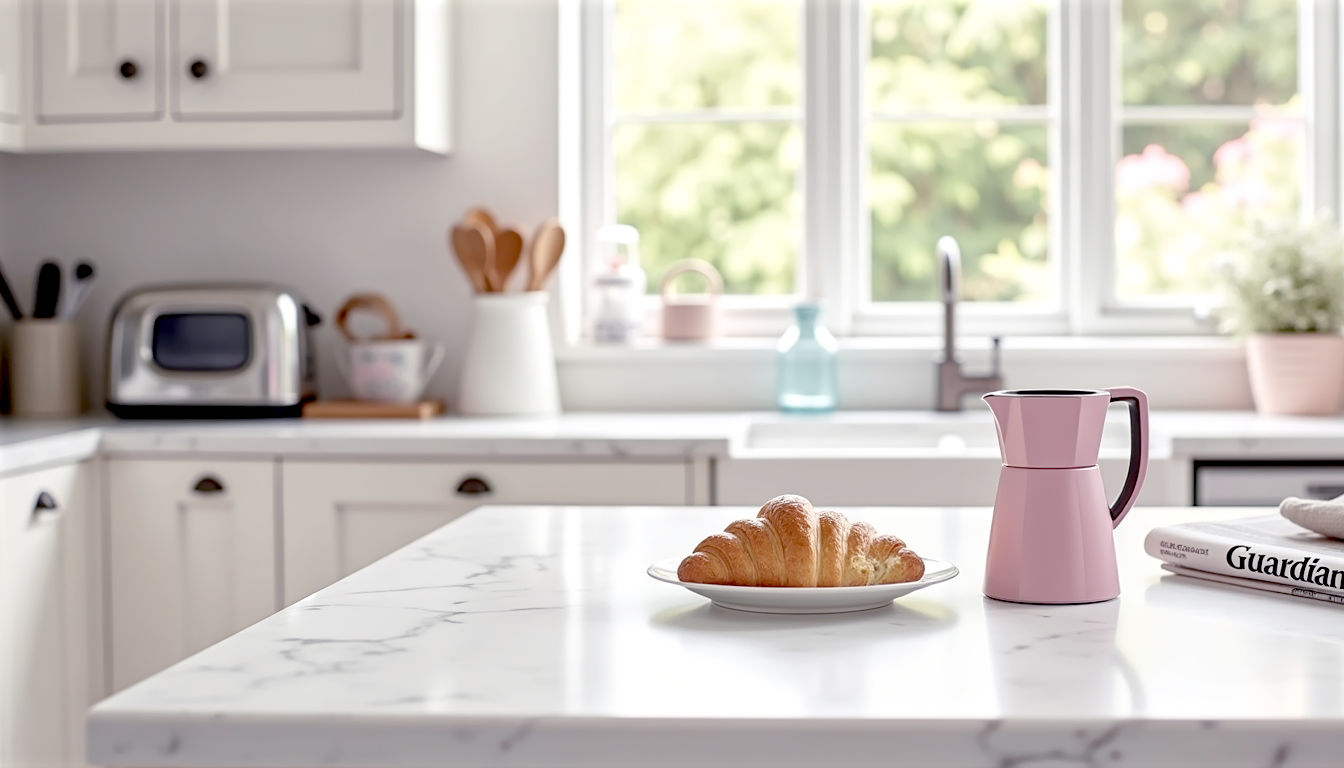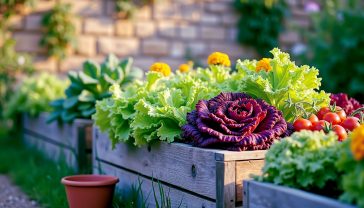The Ultimate Guide to Choosing Your Perfect Kitchen Worktop: A British Homeowner’s Handbook
The definitive guide for UK homeowners on choosing a kitchen worktop. We compare every material, from budget laminate to luxury marble, to fit your style.

This post may contain affiliate links. If you make a purchase through these links, we may earn a commission at no additional cost to you.
The kitchen is the undisputed heart of the modern British home. It’s where we brew that first, life-giving cuppa in the morning, where the kids do their homework, where we whip up a Sunday roast, and where friends inevitably gather during a party. And at the centre of all this action is the kitchen worktop. It’s the unsung hero, the stage upon which daily life unfolds.
But let’s be honest, choosing one can feel like a nightmare. You step into a showroom, and you’re hit with a dizzying array of materials, colours, and finishes. Granite or quartz? Wood or laminate? What on earth is a ‘sintered stone’? It’s enough to make you want to give up and just keep your old, scratched surface from the 90s.
Don’t panic. Think of this as your friendly, no-nonsense guide. We’re going to walk you through everything, step-by-step. By the time you’ve finished reading, you’ll know exactly how to pick the perfect worktop for your budget, your family, and your style. Let’s get started.
Before You Begin: The Three Golden Rules of Worktop Selection
Before you fall in love with a slab of Italian marble that costs more than your car, we need to lay some groundwork. Getting these three things straight from the beginning will make the whole process much easier and save you from costly mistakes.
Rule 1: Settle Your Budget (Honestly!)
It’s not the most exciting part, but it’s the most important. A kitchen worktop is a significant investment, and prices vary wildly. A simple laminate worktop could set you back a few hundred pounds, while a high-end, bespoke stone surface could run into many thousands.
Be realistic about what you can afford. Remember to factor in the hidden costs:
- Delivery: Some materials are incredibly heavy and need specialist handling.
- Templating & Fabrication: For stone or solid surfaces, a professional will need to create a precise template of your kitchen. The cost of cutting sink holes, tap holes, and drainage grooves all adds up.
- Installation: This is not a DIY job for most materials. Professional fitting is essential for a perfect finish.
A Rough UK Cost Hierarchy (from least to most expensive):
- Laminate (£)
- Solid Wood (££)
- Solid Surface (£££)
- Granite (£££)
- Quartz (££££)
- Marble (££££)
- Concrete / Stainless Steel (££££)
- Sintered Stone (£££££)
Having a clear number in mind from the start will immediately narrow down your options and stop you from wasting time considering things that are simply out of reach.
Rule 2: Analyse Your Lifestyle
The perfect worktop for a single person who mostly eats out is completely different from the one needed for a busy family with small children. You need to be brutally honest about how you live and how you use your kitchen.
Ask yourself these questions:
- Who uses the kitchen? Are there mucky pups who are likely to spill Ribena or draw on the surfaces? If so, you need something non-porous and stain-resistant.
- How much do you cook? If you’re a keen chef, you’ll need a surface that can handle hot pans, sharp knives, and plenty of mess. Durability is key.
- Are you a baker? If you fancy yourself the next Star Baker, a naturally cool surface like stone is brilliant for rolling out pastry.
- How much cleaning are you prepared to do? Some worktops, like solid wood, need regular maintenance (oiling). Others, like marble, need immediate attention if you spill red wine. If you’re a ‘wipe-and-go’ kind of person, you’ll want something low-maintenance like quartz.
- Is this your ‘forever home’? If you’re doing up a house to sell in a couple of years, a crowd-pleasing and affordable option might be best. If this is where you’ll be for the next 20 years, it’s worth investing in something you truly love that will stand the test of time.
Rule 3: Define Your Style
Your worktop is a huge visual element in your kitchen – probably the biggest after your cabinets. It needs to work with the overall look you’re trying to achieve.
- Modern & Minimalist: You might lean towards sleek quartz, stainless steel, or a slimline sintered stone in a solid, neutral colour.
- Traditional & Country: Solid wood is the classic choice here, bringing warmth and character. A granite with a softer, speckled pattern also works beautifully.
- Industrial: Think concrete, stainless steel, or even a dark, moody granite or quartz.
- Luxury & Glamorous: Nothing says ‘wow’ like a beautifully veined marble or a high-end quartz that mimics it.
Top Tip: Don’t just look at tiny samples! A pattern that looks subtle on a 10cm square can feel overwhelming across a whole kitchen. Always try to see the largest slab you can, or at the very least, look at lots of pictures of it installed in real kitchens. Take your cabinet door and floor samples with you when you go shopping to see how they all look together in different lights.
The Great Worktop Showdown: A Deep Dive into Materials
Right, with the groundwork done, it’s time for the main event. Here’s the lowdown on the most popular worktop materials available in the UK, with no jargon and no sales pitch.
Laminate: The Sensible Superstar
- What is it? A layer of printed paper or plastic fused to a chipboard core. Modern high-pressure laminates (HPL) are a world away from the cheap, plasticky versions you might remember.
- The Look: Incredibly versatile. It can mimic almost anything – wood, stone, concrete, you name it. Modern laminates have better textures and finishes, with trendy square edges replacing the old-fashioned rounded ones.
- Durability: Pretty good for the price. It’s scratch and stain-resistant to a point, but it’s not indestructible. A deep scratch can’t be repaired, and the chipboard core can be damaged by water if a join isn’t sealed properly. Crucially, it’s not heat resistant – always use a trivet for hot pans, or you’ll be left with a permanent scorch mark.
- Maintenance: A doddle. Just wipe it down with a damp cloth and a standard kitchen cleaner.
- UK Cost Guide: £ (The most affordable option by a long shot).
Verdict: If your budget is tight, laminate is a fantastic choice. It offers a huge range of styles for a fraction of the cost of other materials. Perfect for first homes, utility rooms, or rental properties.
Solid Wood: The Warm and Rustic Charmer
- What is it? Just what it says on the tin – a worktop made from solid staves of wood. Popular choices in the UK include oak, beech, walnut, and iroko.
- The Look: Beautiful, warm, and full of natural character. It gives a kitchen a cosy, inviting feel, perfect for country or traditional styles. Every piece is unique.
- Durability: It’s a bit of a mixed bag. Wood is naturally soft, so it will scratch and dent over time – but many people think this just adds to its character, like a well-loved old pub bar. It’s naturally antibacterial, which is a bonus. However, it’s not very resistant to heat or stains, and it can scorch or warp if you’re not careful. Water is its enemy – you must keep the area around the sink well-oiled and sealed.
- Maintenance: This is the big one. A wooden worktop needs regular care. You’ll need to sand it down and re-oil it every 6-12 months to keep it protected and looking its best. The good news is that if you do get a scratch or a stain, you can usually just sand it out.
- UK Cost Guide: ££
Verdict: Choose wood for its beauty and character, not for its practicality. It’s a wonderful material if you love its look and are prepared to put in a bit of effort to look after it.
Granite: The Natural Powerhouse
- What is it? A 100% natural igneous rock, cut from quarries around the world, sliced into slabs, and polished.
- The Look: Each piece of granite is completely unique, with its own natural patterns, colours, and flecks. This is a huge part of its appeal. It comes in a vast range of colours, from deep blacks and greys to vibrant blues and greens. It has a glossy, substantial feel that screams quality.
- Durability: It’s tough as nails. Granite is incredibly hard, making it very difficult to scratch. It’s also one of the most heat-resistant materials you can get – you can put a hot pan straight on it without any issues (though it’s still good practice to use a trivet). Its weakness is that it’s slightly porous.
- Maintenance: Because it’s porous, it needs to be sealed by the installer and then re-sealed every year or so. This stops liquids like wine or oil from seeping in and causing a permanent stain. Once sealed, it’s easy to clean with just soapy water.
- UK Cost Guide: £££
Verdict: A brilliant, hard-wearing choice that adds real value to your home. If you want a natural stone with unique character that can handle the heat of a busy kitchen, granite is one of the best options out there.
Quartz (Engineered Stone): The Unbeatable All-Rounder
- What is it? An engineered material made from about 90-95% crushed natural quartz mixed with resin and pigments. It’s then formed into slabs under immense pressure.
- The Look: Because it’s man-made, quartz offers a huge and consistent range of colours and patterns. You can get solid bright whites, which are impossible in natural stone, or patterns that perfectly mimic the look of marble or concrete but without the drawbacks. The pattern is the same all the way through the slab.
- Durability: This is where quartz really shines. The resin makes it completely non-porous, so it will never stain. It’s also incredibly hard and scratch-resistant. The only slight chink in its armour is heat resistance – the resin can be damaged by extreme temperature changes, so you should always use a trivet for hot pans.
- Maintenance: The easiest of the lot. It never needs sealing. You just wipe it clean. It’s hygienic, stain-proof, and fuss-free.
- UK Cost Guide: ££££
Verdict: For a busy modern family, quartz is arguably the best all-round choice. It combines the beauty of stone with bomb-proof durability and zero maintenance. It’s no wonder it has become the UK’s most popular premium worktop material.
Marble: The Luxurious Icon
- What is it? Another natural stone, a metamorphic rock famous for its beautiful, distinctive veining. Carrara and Calacatta are two of the most famous types.
- The Look: Simply stunning. Marble is timeless, elegant, and the ultimate statement of luxury. Its soft, milky appearance and dramatic veins are instantly recognisable and have been prized for centuries.
- Durability: Here’s the catch. Marble is the diva of the worktop world. It’s much softer than granite, so it scratches and chips easily. It’s also very porous and is particularly vulnerable to anything acidic (lemon juice, vinegar, wine) which can etch the surface, leaving a dull spot. Stains are a constant risk.
- Maintenance: High. It needs to be sealed professionally and regularly. Spills must be wiped up immediately. Many people in Europe embrace the ‘patina’ that marble develops over time – the collection of stains and etches that tell the story of a well-loved kitchen. You have to be prepared to accept this.
- UK Cost Guide: ££££
Verdict: Buy marble with your heart, not your head. It is unmatched for beauty, but it is high-maintenance and will show signs of wear. It’s for the careful homeowner who values aesthetics above all else.
Solid Surface: The Seamless Wonder
- What is it? A man-made composite of acrylic resins and minerals. Corian is the most famous brand name, but there are others like Hi-Macs and Staron.
- The Look: Its superpower is that it can be joined seamlessly. This means you can have huge runs of worktop, integrated sinks, and coved upstands with no visible joins. This creates a very smooth, clean, and modern look. It comes in a huge range of colours, often solid and uniform.
- Durability: It’s non-porous and hygienic. However, it is quite soft and scratches more easily than stone or quartz. It’s also not very heat resistant. But, its other superpower is that it’s repairable. Scratches can be polished out by a professional, making the surface look as good as new.
- Maintenance: Easy to clean on a day-to-day basis. Just avoid abrasive scourers which can dull the surface.
- UK Cost Guide: £££
Verdict: A great mid-range option if you love a super-sleek, seamless look with an integrated sink. A fantastic choice for unusually shaped kitchens.
Other Contenders for Your Consideration
- Stainless Steel (££££): The choice of professional chefs for a reason. It’s totally hygienic, heat-proof, and stain-proof. On the downside, it scratches very easily (though this becomes a uniform patina over time) and shows every single fingerprint. Gives a very industrial, functional look.
- Concrete (££££): Poured and polished for a unique, industrial, and very on-trend look. It’s incredibly heavy and must be sealed properly to prevent staining. Hairline cracks can develop over time, which is either a flaw or part of its rustic charm, depending on your point of view.
- Sintered Stone (£££££): The new kid on the block. Brands like Dekton and Neolith are made by fusing natural minerals together under extreme heat and pressure. The result is an ultra-compact surface that is virtually indestructible. It’s scratch-proof, stain-proof, heat-proof, and even UV-proof, so it won’t fade in the sun. The downside is the high price tag and the need for specialist fabrication.
Material Comparison at a Glance: A Handy Cheat Sheet
| Material | UK Cost | Durability | Maintenance | Style Vibe |
|---|---|---|---|---|
| Laminate | £ | Fair | Very Low | Versatile / Budget-Friendly |
| Solid Wood | ££ | Fair | High | Warm / Rustic / Traditional |
| Granite | £££ | Very High | Medium | Natural / Classic / Unique |
| Quartz | ££££ | Excellent | Very Low | Modern / Consistent / Polished |
| Marble | ££££ | Low | High | Luxurious / Elegant / Timeless |
| Solid Surface | £££ | Good | Low | Seamless / Modern / Clean |
| Sintered Stone | £££££ | Exceptional | Very Low | Ultra-Modern / Industrial / Sleek |
The Finer Details: Getting the Finish Right
Once you’ve chosen your material, you’re not quite done. A few final choices will make a big difference to the finished look.
Choosing Your Worktop’s Thickness
- Standard (30-40mm): This is the classic thickness, especially for materials like laminate, wood, and granite. It gives a solid, substantial look.
- Slimline (12-20mm): A growing trend, particularly in modern kitchens. Thinner worktops, especially in quartz or sintered stone, create a very sleek, elegant, and minimalist profile.
Perfecting the Profile: A Guide to Worktop Edges
For stone and solid surface worktops, you can choose the shape of the edge.
- Square/Pencil: A simple, clean, and slightly rounded edge. The most popular choice for modern kitchens.
- Bullnose: A fully rounded edge, which is a softer, more traditional look.
- Ogee/Dupont: Fancier, more decorative profiles that suit very traditional or luxury kitchens.
Upstands and Splashbacks: The Unsung Heroes
- Upstand: A small lip (usually around 100mm high) of the same worktop material that runs along the wall. It gives a very neat, premium finish and covers any unevenness in the wall, meaning you don’t need a thick line of silicone sealant.
- Splashback: A larger panel of material that covers the wall, typically behind the hob or sink. You can use the same material as your worktop for a cohesive look, or choose something different like glass, tiles, or stainless steel to create a feature.
The Journey from Showroom to Your Kitchen: The Installation Process
For anything other than off-the-shelf laminate or wood, you’ll follow a standard process.
- Step 1: Measuring and Templating: Once your base cabinets are fully installed and level, a professional from the worktop company will visit. They will create an exact template of your worktops using thin strips of wood or plastic, or a digital laser templating device. This is your chance to confirm the final details like tap hole positions and edge profiles.
- Step 2: Fabrication: The template is taken back to the factory, where your chosen slab of material is precisely cut to size using advanced machinery. All the cut-outs for your hob and sink are made at this stage. This can take a week or two.
- Step 3: Installation Day: The same team will usually return to fit the finished worktops. This can be a dusty job! They will carefully place the pieces, seal any joints with coloured epoxy resin, and fit your sink.
Common Mistakes to Avoid (And How to Get It Right)
- Ignoring Your Lifestyle: Don’t buy high-maintenance marble if you have three young kids and no time to clean. Be honest with yourself!
- Forgetting About Maintenance: Understand what your chosen material needs before you buy it. If you’re not prepared to oil a wooden worktop, don’t get one.
- Choosing Based on a Tiny Sample: A small square doesn’t show the whole picture, especially with heavily patterned natural stone. Ask to see the full slab if possible.
- Hiring the Wrong Installer: A cheap installation can ruin an expensive worktop. Always use a reputable firm, ideally one recommended by your kitchen supplier. Check their reviews and ask to see photos of their work.
Conclusion: Crowning Your Kitchen
Choosing a new kitchen worktop is a big decision, but it doesn’t have to be a stressful one. By breaking it down into the three golden rules – budget, lifestyle, and style – you can quickly narrow your focus.
Think of your worktop as a long-term investment in the enjoyment and functionality of your home. It’s the surface where you’ll prepare thousands of meals, share countless conversations, and make lasting memories. Take your time, do your research, and choose the material that doesn’t just look right, but feels right for the way you live. Your perfect kitchen is waiting.
Further Reading
For more inspiration and expert advice, we recommend these excellent UK resources:
- Ideal Home: A fantastic resource for real-home inspiration and practical advice on kitchen design.
- Grand Designs Magazine: For those looking for cutting-edge materials and architectural inspiration.
- Houzz UK: A huge online community and photo gallery where you can see thousands of British kitchens and connect with local professionals.
- The Kitchen Think: An independent source of advice and information from the UK Kitchen Bathroom Bedroom Specialists Association (Kbsa).






